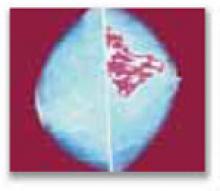User login
<court>Cuyahoga County (Ohio) Court of Common Pleas</court>
From 1996 to 1998, a 62-year-old woman had 3 mammograms—all of which were read as normal. In 2000, she was diagnosed with intraductal carcinoma stage IIB of the right breast.
The patient underwent extensive chemotherapy and, at the time of trial, her life expectancy was reported to be several weeks to months.
In suing, the woman claimed that there were several suspicious calcifications on her mammogram from 1998 that should have prompted the doctor to order further studies or a biopsy.
The doctor contended that his interpretation was accurate and well within the standard of care. In addition, he argued that an earlier diagnosis would not have changed the patient’s outcome.
- The jury returned a defense verdict.
The cases presented here were compiled by Lewis L. Laska, editor of Medical Malpractice Verdicts, Settlements & Experts. While there are instances when the available information is incomplete, these cases represent the types of clinical situations that typically result in litigation.
<court>Cuyahoga County (Ohio) Court of Common Pleas</court>
From 1996 to 1998, a 62-year-old woman had 3 mammograms—all of which were read as normal. In 2000, she was diagnosed with intraductal carcinoma stage IIB of the right breast.
The patient underwent extensive chemotherapy and, at the time of trial, her life expectancy was reported to be several weeks to months.
In suing, the woman claimed that there were several suspicious calcifications on her mammogram from 1998 that should have prompted the doctor to order further studies or a biopsy.
The doctor contended that his interpretation was accurate and well within the standard of care. In addition, he argued that an earlier diagnosis would not have changed the patient’s outcome.
- The jury returned a defense verdict.
The cases presented here were compiled by Lewis L. Laska, editor of Medical Malpractice Verdicts, Settlements & Experts. While there are instances when the available information is incomplete, these cases represent the types of clinical situations that typically result in litigation.
<court>Cuyahoga County (Ohio) Court of Common Pleas</court>
From 1996 to 1998, a 62-year-old woman had 3 mammograms—all of which were read as normal. In 2000, she was diagnosed with intraductal carcinoma stage IIB of the right breast.
The patient underwent extensive chemotherapy and, at the time of trial, her life expectancy was reported to be several weeks to months.
In suing, the woman claimed that there were several suspicious calcifications on her mammogram from 1998 that should have prompted the doctor to order further studies or a biopsy.
The doctor contended that his interpretation was accurate and well within the standard of care. In addition, he argued that an earlier diagnosis would not have changed the patient’s outcome.
- The jury returned a defense verdict.
The cases presented here were compiled by Lewis L. Laska, editor of Medical Malpractice Verdicts, Settlements & Experts. While there are instances when the available information is incomplete, these cases represent the types of clinical situations that typically result in litigation.
